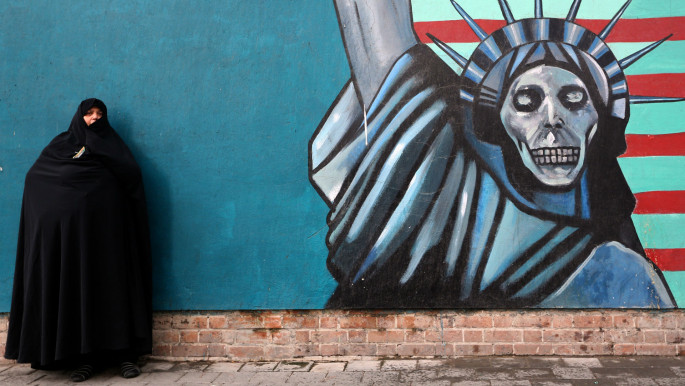
US pivots toward new era of engagement with Iran
In October of 1951, Winston Churchill met the US general Dwight Eisenhower in London during a conference of members from the newly formed Nato alliance.
Churchill was on the verge of another term as prime minister of the UK, while Eisenhower was mulling a run for the presidency in 1952. Both men, however, were more focused on shaping a response to the looming threat of the Soviet Union.
In one of their private conversations, Eisenhower expressed his worry to Churchill over Nato's ability to win a European war against the Soviets. The alliance, he told Churchill, was outgunned and outmanned - Nato had 21 divisions to the Soviet Unions' 200.
The Nato agreement, Eisenhower argued, was "little more than a few scraps of paper" and it would take many years to build a credible military alliance. After reciting these facts, Eisenhower shook his head, turned to Churchill and asked: "What the hell are we going to do?"
Netanyahu goes nuclear... prepare for the fallout. Read Jonathan Cook.
Churchill, in one of his few phlegmatic moments, waved aside Eisenhower's alarm. "What we're going to do," he said, "is wait." Churchill then went on to explain that, in his view, the Soviet state was untenable. "It can't survive," he argued. "It doesn't work."
Eisenhower was taken aback by this, in large part because Churchill, with whom he maintained a close personal relationship, seemed so certain in his views. "That's fine, we'll wait," Eisenhower said, after a long pause. "But for how long?"
Churchill shrugged. "It'll take about 50 years," he predicted, "but that's about it."
As it turns out, Churchill was off target. The Soviet Union collapsed in 1991, 40 years and two months after Churchill's prediction.
But in a far more crucial sense, Churchill was literally on the money: the backbone of the US-European alliance did not lie in its military strength, but its economic muscle - and its patience. The real conflict was not between militaries, but systems.
In such a contest, as Churchill calculated, the fires that fuelled the Russian revolution would inevitably be suffocated by the grim realities that face every government. The Soviet Union was inevitably going to have to feed its own people - and it couldn't.
The same kind of thinking can be discerned in the US decision to open up to Iran. For while the US and its allies (the so-called P5+1) are focused on Iran's nuclear programme, that rather narrow though vital brief veils a much larger strategy - a new "pivot" that is intended to shift US-Iranian relations.
| That rather narrow though vital brief of the nuclear programme veils a much larger strategy - a new "pivot" that is intended to shift US-Iranian relations. |
That strategy takes as its starting point the belief that the fires that once fed Iran's revolution are being extinguished by the Islamic Republic's desire to end its international isolation.
As was the case with the Soviet Union, successive Iranian governments are under mounting pressure from their constituents, and their influential business and financial sectors, to take steps that would lift sanctions that have crippled economic growth.
That Iran is ripe for change remains a controversial topic in the US Congress, most of whose members remain skeptical of Iranian intentions. While it's true that Congress is heavily influenced by the Israel lobby, the continuing doubts also reflect the three decades of conflict where US forces squared off against Iranian proxies in Lebanon in the 1980s, and then in the wake of the 2003 invasion of Iraq.
During 1987 and 1988, the US ran Operation Earnest Will against Iranian threats to oil tanker shipping in the Gulf, a quieter though no less dangerous a struggle.
The skepticism of the US Congress is also reflected by a large and vocal contingent of retired senior military officers, particularly those who served in the US navy and marines.
A tightly knit "marine corps mafia", for instance, remains adamantly opposed to any opening with Iran, primarily because senior career marine officers retain vivid memories of the 1983 Iran-engineered Beirut barracks bombing – which killed 241 Americans, almost all of them marines.
"This was a very real trauma for the Marine Corps," said Joseph Hoar, a retired general who also commanded US forces during Operation Earnest Will. "And it's been hard for many marines to put it in the past. There's no such thing as ancient history when it comes to something like that."
But while the US Congress and a large contingent of retired officers remain skeptical of the Obama administration's Iran opening, the same does not hold true for those currently in uniform, or for many current policymakers.
The differences can be profound. A little less than three years ago, in the spring of 2011, senior US navy officers serving in the US Central Command briefed its then-commander, James Mattis, on the likely outcome of a US-Iranian military confrontation.
Their conclusion was that in Iran stood little chance of prevailing in a strictly military contest. But a large community of advisers to Mattis strongly disagreed, according to a currently serving senior military officer and Iran expert, and provided their own assessment.
 |
|
| The US is seeking to change 30 years of hostile relations |
Their briefing paper, issued late in 2011, concluded that a war with Iran would result in a US victory, but only after "a protracted air campaign" that would likely be "long and bloody".
That assessment marked a decisive shift on the views of Iran among currently serving US military officers, a senior Pentagon official told me several weeks ago.
"The US military doesn't give the president advice on how to conduct our foreign policy," the official said. "But I can tell you from my own discussions that the military sees only three options when it comes to Iran: We can engage them, we can refuse to engage them, or we can go to war with them. No one in their right mind would ever choose the third option. This is a no-brainer."
That view was echoed this last December during a private dinner of retired US air force officers, during which David Goldfein, the current staff director of the Joint Chiefs of Staff, an influential and prestigious position in the US military, reviewed the status of US military forces in the Gulf.
According to a former senior US officer who attended the dinner, Goldfein presented a series of slides of US military assets in the Gulf region.
The slides showed a successive build-up of US air and naval assets – a reflection of the US commitment to protect Bahrain, Qatar, Kuwait, the UAE and Saudi Arabia. But in the middle of this presentation, Goldfein flipped the slide, showing how the build-up of US forces in the Gulf looked from Iran's point-of-view.
"From our perspective," Goldfein was quoted as saying, "it looks like we're providing protection and stability, but from Iran's perspective, this looks like a threat."
While Goldfein's presentation provides a single data point on US military views on Iran, his willingness to show different perspectives on US power is emblematic of the larger shift on Iran that has taken place in the US policymaking establishment.
It is a fundamental and profound shift away from a strategy of isolation - of "waiting", to use Churchill's phrase - to an era of engagement. And so it is that in the middle of the Obama administration's celebrated "pivot" to Asia, the real pivot that the world is witnessing is a pivot to Iran.





 Follow the Middle East's top stories in English at The New Arab on Google News
Follow the Middle East's top stories in English at The New Arab on Google News


